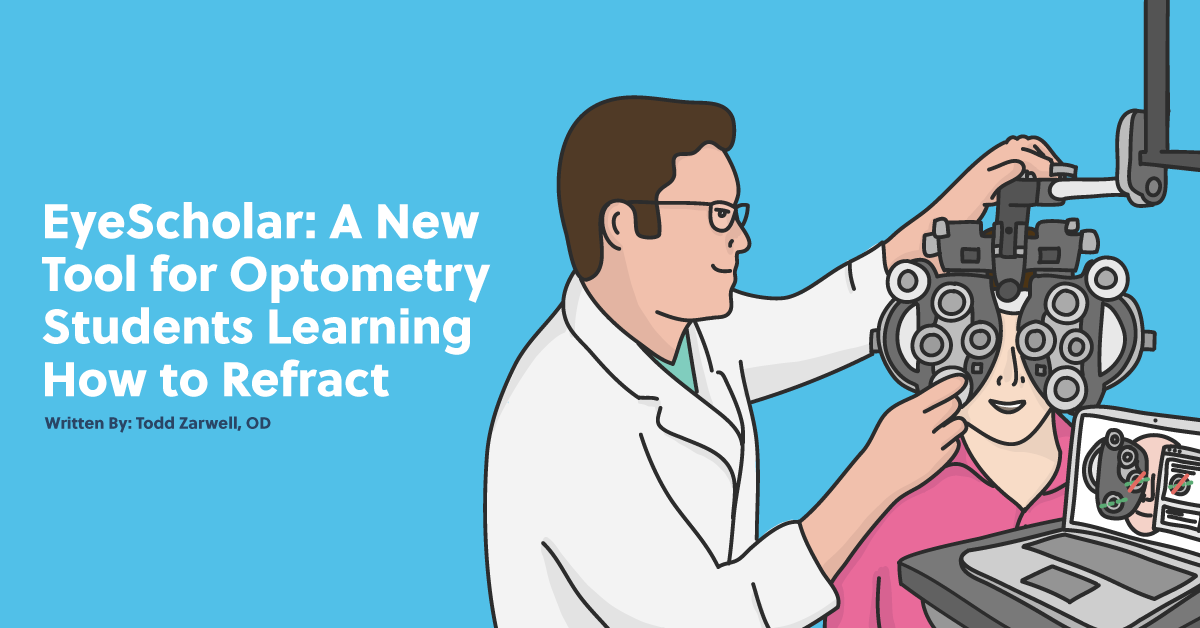Todd Zarwell, OD has launched a new tool for students learning and practicing subjective refraction and retinoscopy on EyeScholar. The tutorial features refraction and retinoscopy tutorials, and both refraction and retinoscopy simulators—perfect for students who want to practice both processes before their first patient encounters.
The purpose of the tutorial is to give students the ability to learn these clinical skills at their own pace and to allow them to practice on many different types of patients. “When I was in optometry school we had a limited amount of space and a limited amount of time in the practice lanes, which made it difficult to get the repetition needed to become proficient at refracting and retinoscopy,” says Dr. Zarwell.
“Furthermore, most of the people I had available to practice on were people like me: Simple myopes in their mid-20s that refracted to a nice, clean 20/15. There was very little opportunity to practice on people with complicated refractive errors or reduced BCVA until we started seeing patients in the clinic. And, even if I could recruit ‘real’ patients to practice on, I always felt guilty subjecting them to a fumbling, 20 minute refraction.”
The refraction tutorial includes videos and interactive lessons explaining the steps of subjective refraction. These tutorials allow you to actively work with a virtual patient by presenting them with choices while you manipulate the controls on a simulated refracting instrument.
Once students are familiar with the steps of refraction they can begin to practice their skills on virtual patients. Because the patients are randomly generated, there are a limitless number of people to practice on and, just like in real life, they can be myopic, hyperopic, astigmatic, presbyopic, or have limited visual acuity. In addition, you can develop the mental fortitude to handle individuals who just can’t seem to give straightforward “one” or “two” responses (e.g. “This one is worse”).
While there is no substitute for working with a real physical instrument, the simulator allows you to take your time and think about your patient’s responses and decide what power changes to make.
The interactive retinoscopy tutorials use animations to illustrate the optics of retinoscopy, how to recognize with-motion, against-motion, and neutrality, as well as recognizing astigmatism and identifying principal meridians.
The retinoscopy simulator allows the user to neutralize retinoscopy reflexes, using either trial lenses or a refracting instrument. The retinoscopy reflex behaves in a realistic way, allowing you to make observations, then manipulate the instrument controls and lenses. When you think you’re done, you can compensate for your working distance, then compare your result to the patient’s true Rx.
All tutorials and simulators are available in plus or minus cylinder.
Dr. Zarwell acknowledges that a simulator has limitations for teaching clinical skills. “I’ve been developing this tutorial for over 5 years, and I’m very proud of it, but I’ll be the first to admit that there is no substitute for physically spinning dials and interacting with a real patient,” he says. “However, I also feel that the ability to learn and practice—and make mistakes—on virtual patients is an extremely useful supplement to traditional teaching methods.”
Dr. Zarwell has been developing websites and apps for his fellow eye care professionals for nearly 20 years, including the contact lens database and calculators at eyedock.com and the Parks Three Step iPhone app.
Learn more about EyeScholar by watching Dr. Zarwell’s announcement video, or head straight to the website to learn about the features and sign up!
